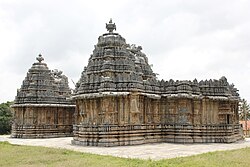Nageshvara-Chennakeshava Temple complex, Mosale
Nageshvara-Chennakeshava Temple complex | |
|---|---|
Hindu temple | |
 Nageshvara (near) and Chennakeshava (far), 1200 C.E., in Mosale, Hassan district | |
 | |
| Country | |
| State | Karnataka |
| District | Hassan District |
| Languages | |
| • Official | Kannada |
| Time zone | UTC+5:30 (IST) |
| PIN | 577146 |

The Nageshvara-Chennakeshava temple complex (also spelt Nagesvara and Chennakesava) is an elegant example of Hoysala architecture of the early 12th century. It is located in the village of Mosale, about 10 km from Hassan city, in Hassan district of Karnataka state, India.[1] The temple was built in 1200 A.D. during the reign of Hoysala King Veera Ballala II.[2][3] According to art historian Gerard Foekema, the two temples that are built in the same complex, in an idyllic rural setting, form a "perfect twin".[4] This temple complex is protected as a monument of national importance by the Archaeological Survey of India.[5]
Architecture
By plan, the temples are simple single-shrined structures with all the standard features of Hoysala architecture; a porch entrance into a square closed mantapa or navaranga (hall with no windows and a thick wall) leading to the sanctum, and a superstructure (shikhara) over the main shrine fitting the description of a ekakuta (single shrine with top). The sanctum (garbhagriha) is connected to the hall by a vestibule called sukhanasi. The closed hall, whose inner and outer walls are decorated, has four central lathe turned pillars that support a bay ceiling.[2][3][6][7][8] The temples are constructed next to each other. The Nageshvara temple (lit, "Lord of snakes"), dedicated to the Hindu god Shiva (represented by his universal symbol, the linga) is in the south. The Chennakeshava temple (lit, "beautiful Vishnu"), dedicated to a standing cult image of the Hindu god Vishnu, is to the north. Since all features are replicated in the temples, Gerard Foekema considers the ensamble a dvikuta (two shrines with two towers).[2][9][10]
The superstructure (tower or shikhara) over each shrine is three tiered (tritala arpita) and vesara in style. It is intact, finely sculptured and has a decorative low extension which is actually the tower over the vestibule (that connects the cella (sanctum) and the hall). The extension tower looks like the "nose" of the main superstructure and is also called sukhanasi. The sukanasi structure holds the beautiful Hoysala crest that depicts a royal warrior stabbing a lion.[3][6][7] At the top of the superstructure of the shrine is a "helmet" like sculptured dome (amalaka) whose ground surface area can be 2x2 meters. It is the largest piece of sculpture in the temple. The amalaka supports a decorative water pot like structure called the kalasha which is the apex of the tower.[11] All these features are intact in both temples.[2]
The decorative features found on the temple outer wall (horizontal treatment) belong to the "old kind". In this type of decorations, below the superstructure, an eaves that projects about half a meter runs all around the temple. Below the eaves are decorative miniature towers (aedicula) on pilasters. In the "old kind", the large wall images of deities and their attendants are placed below these decorative towers. Some of these images appear damaged, but there are others that require special mention for their elegance and art. The panel images at the Nageshvara temple have their names on their pedestals. Some of these are images of Sridevi, Lakshmidevi, Gauri, Maheshvari (another name for Parvati), Brahma, Sadashiva (form of Shiva) and Bhumidevi (representation of mother earth). The Channakeshava temple has sculptures of Garuda (the eagle), Keshava (a form of Vishnu), Janardana, Venugopala, Madhava (a form of Krishna) and Bhudevi. Below these images, the base of the wall comprises five different horizontal moldings, one of which is a row of blocks.[2][3][7][12]
Gallery
-
The Beautiful Twin Temples of Mosale - Nageshvara on the left and ChennaKesava on the right
-
Frontal view of twin temples, Nageshvara (far), Chennakeshava (near) at Mosale
-
A decorative shrine in the mantapa wall of Chennakeshava temple at Mosale
-
Nageshvara Temple - Mosale
-
Vesara tower of the Chennakeshava temple, Mosale
-
Wall panel relief sculpture and ornamentation in Chennakeshava temple at Mosale
-
Yali sculpture on wall of Chennakeshava temple at Mosale
-
Ornate domical bay ceiling in mantapa of Nageshvara temple at Mosale
-
Ornate domical bay ceiling in mantapa of Chennakeshava temple at Mosale
-
Closed mantapa with lathe turned pillars facing sanctum in Nageshvara temple at Mosale
-
Old Kannada inscription (1577 A.D.) of Belur Chief Venkatadri Nayaka at the twin temple complex at Mosale
-
North Side corner View of the twin temples at Mosale
-
Frontal view of the Nageshvara-Chennakeshava - twin Temples of Mosale
Notes
- ^ Foekema (1996), pp81-82
- ^ a b c d e Foekema (1996), p82
- ^ a b c d "Nagesvara and Chennakesava temples". ASI Bengaluru Circle. Archaeological Survey of India. Retrieved 9 August 2012.
- ^ Foekema (1996), p81
- ^ "Alphabetical List of Monuments - Karnataka - Bangalore, Bangalore Circle, Karnataka". Archaeological Survey of India, Government of India. Indira Gandhi National Center for the Arts. Retrieved 10 August 2012.
- ^ a b Foekema (1996), p22
- ^ a b c Kamath (2001), p134
- ^ Kamath (2001), p135
- ^ Foekema (1996), pp19-20
- ^ Foekema (1996), p25
- ^ Foekema (1996), p27
- ^ Foekema (1996), p28
References
- Gerard Foekema, A Complete Guide to Hoysala Temples, Abhinav, 1996 ISBN 81-7017-345-0
- Kamath, Suryanath U. (2001) [1980]. A concise history of Karnataka: from pre-historic times to the present. Bangalore: Jupiter books. LCCN 80905179. OCLC 7796041.
- "Nagesvara and Chennakesava temples". Archaeological Survey of India, Bengaluru Circle.














